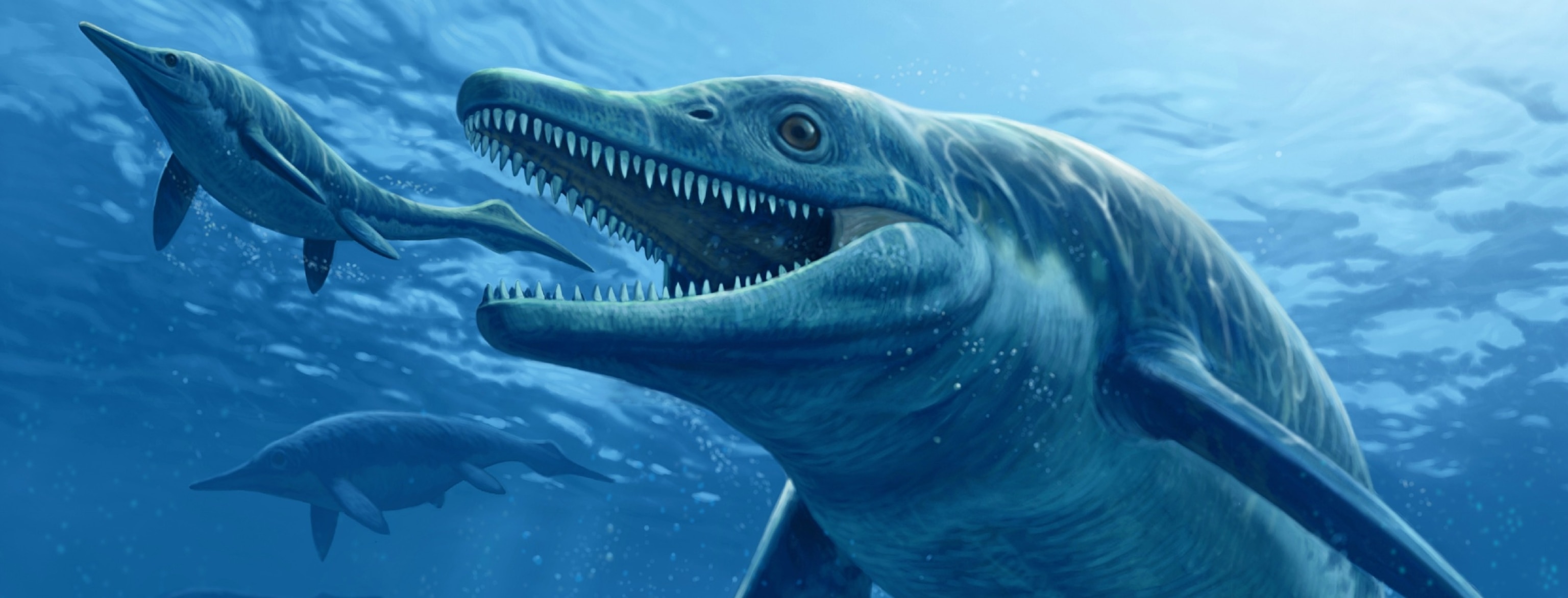A few weeks ago, as we chatted over dinner, some paleo-minded friends and I debated when the safest time to take a dip in the prehistoric oceans might have been. We immediately ruled out the Mesozoic. From the Triassic to the end of the Cretaceous 66 million years ago, the marine realm was dominated by successive arrays of big, toothy, apex predators that crunched prey just as large, if not larger, than they were. Pliosaurs, marine crocodiles, and mosasaurs thrived in ancient seas, each radiation stranger and scarier than what had come before. And, so far as we know, the long tradition of macropredatory marine reptiles started with a roughly 245 million year old ichthyosaur that bore a vicious grin double-edged teeth.

Paleontologist Nadia Fröbisch and colleagues have named the predator Thalattoarchon saurophagis – the “lizard-eating ruler of the seas” – in today’s issue of PNAS. Fossil preparator Jim Holstein found the animal while searching the Middle Triassic rock of Nevada’s Augusta Mountains in 1997. After the specimen was finally collected in 2008, the fossil proved to comprise the back of the skull, much of the vertebral column, parts of the hips, and elements of the rear fins from a single animal with an estimated length of 28 feet. What’s left of the carnivore’s head is what makes Thalattoarchon so fearsome and so noteworthy.
Look into the petrified mouth of almost any ichthyosaur and you’ll find lots of simple, pointed, conical teeth. This is the dental arrangement of a grabber – a predator that catches small, slippery prey such as fish and squid. The teeth of Thalattoarchon are an exception to the ichthyosaurian rule. Measuring about four inches tall, with a two inch crown, the largest Thalattoarchon tooth is blade-like, compressed from side-to-side and bearing two cutting surfaces. The sharp surfaces are not serrated, but, in overall form, the dental armaments resemble the teeth of mosasaurs, large pliosaurs, some marine crocodiles, and one later ichthyosaur called Himalayasaurus tibetensis. All of these animals, paleontologists suspect, were marine macropredators.

Unfortunately, the front portion of the sole Thalattoarchon skull eroded away before the animal was collected. Yet, from the back of the cranium, Fröbisch and collaborators were able to determine that Thalattoarchon had large eyes – the animal’s orbit is about a foot across – and a head that was almost twice as large for its body size compared to contemporary ichthyosaurs.
Other animals found in the same strata may help explain why Thalattoarchon was so well-armed. The quarry where the creature was discovered has yielded multiple specimens of other ichthyosaurs – mostly the similarly-sized Cymbospondylus, and the much smaller Phalarodon. All of these animals were descendants of land-dwelling reptiles that slipped into the water and rapidly became adapted to lives spent entirely at sea, part of a great reptilian invasion of the oceans that started early in the Triassic. Nothing like them had ever existed before, and today’s whales continue the marine tetrapod legacy that ichthyosaurs and other marine reptiles pioneered.

The new study does not present any direct evidence of ichthyosaur-on-ichthyosaur predation, but, based on the anatomy of the newly-described predator and the local richness of other marine reptiles, Thalattoarchon may have been a top predator that was especially adapted to hunting other ichthyosaurs. Gut contents, coprolites, and tooth-marked bones would help test this hypothesis.
But the fact that Thalattoarchon existed at all tells us something important about life 245 million years ago. A macropredaceous ichthyosaur could not have evolved unless lower levels of the trophic scale – the producers, first order consumers, and so on – were already in place. Specialized apex carnivores only appear when communities hit a particular level of productivity and richness, otherwise there simply isn’t enough for them to consume. This tells us something importance about the tempo of evolution following a disaster.
Thalattoarchon lived only about five million years after the worst mass extinction the world has ever seen. During this catastrophic event – likely triggered by massive volcanic outpourings that dramatically altered the atmosphere, the climate, and the oceans – as much as 95% of known marine species perished. (Life on land was also hard-hit, but didn’t come quite so close to oblivion.) Denuding life on Earth so drastically necessitated a period of recovery, Fröbisch and coauthors point out, and what Thalattoarchon shows is that at least some oceanic environments were able to bounce back within just a few million years of the mass extinction. Species that were resilient enough to survive the end-Permian devastation set the stage for the next 250 million years of evolution, including the origin of toothy oceanic terrors.
[The Thalattoarchon research was supported in part by the National Geographic Society.]
Reference:
Fröbisch, N., Fröbisch, J., Sander, P., Schmitz, L., Rieppel, O. 2013. Macropredatory ichthyosaur from the Middle Triassic and the origin of modern trophic networks. PNAS Early Edition: http://www.pnas.org/cgi/doi/10.1073/pnas.1216750110

